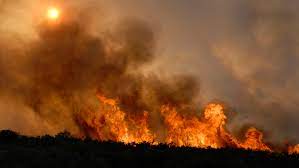Study: Air purifiers may not be effective enough to remove harmful gases left behind by wildfire smoke in floors and homes
When the air is murky and brown from wildfire smoke, you could consider staying indoors with the windows closed, turning on an air purifier, or even donning a mask.
All of these are effective ways to lessen exposure to the particles in wildfire smoke, but smoky air also contains a number of potentially dangerous chemicals. These gases may enter structures and stay for weeks in the floors and walls.
It takes more than just turning on an air purifier or opening a window on a clear day to get rid of harmful pollutants.
My colleagues and I monitored the lifespan of these gases in a house that was exposed to wildfire smoke in a recent research that was published in the journal Science Advances. We also discovered that the easiest strategy to eliminate the danger is also one of the most straightforward: start cleaning.
Gases and smoke particles provide a difficulty.
A number of my friends and coworkers were impacted by the Marshall Fire in December 2021, which destroyed around 1,000 residences in Boulder County, Colorado. The “lucky” ones whose houses were still standing enquired of me as to how they ought to clean them.
I began researching the published papers since I’m an atmospheric and indoor chemist, but there aren’t many that address what occurs when smoke enters a structure.
Scientists were aware that smoke vapors settle on interior surfaces such floors, walls, and ceilings. We were aware that air filters might clear the air of particulates. Moreover, my coworkers and I were just starting to realize that volatile organic compounds, which are typically believed to remain in the air, could actually adhere to surfaces inside a home and accumulate reservoirs – invisible pools of organic molecules that could contribute to the air chemistry inside the house.
Organic substances that are readily converted into gases at room temperature are known as volatile organic compounds, or VOCs. They range from benzene in gasoline to limonene in lemons. While not all VOCs are harmful to human health, many of the VOCs in smoking are. I began to wonder whether the volatile organic compounds (VOCs) in smoke from wildfires may potentially adhere to a home’s surfaces.
In 2022, during the Chemical Assessment of Surfaces and Air, or CASA, project, I collaborated with scientists from all around the US and Canada to investigate this issue. We expanded on HOMEChem, a prior investigation on the effects of cooking, cleaning, and occupancy on indoor air quality.
In CASA, we looked at what happens to pesticides, pollution, and even wood smoke when they enter our houses.
then produced a very chemically precise wildfire smoke proxy using a cocktail smoker and wood chips, and then dispersed tiny amounts of it inside a test home constructed by the National Institute of Standards and Technology. We were able to do controlled chemical experiments in a real-world situation at NIST’s residence.
To replicate what occurs when smoke travels over great distances, such as the smoke from Canadian wildfires that migrated into the US in the summer of 2023, we even aged the smoke in a big bag with ozone.
As smoke moves through the air, its chemical composition changes: Particles becoming more oxidized and brown, while VOCs degrade and the smoke loses its unique fragrance.
The behavior of VOCs in your house
It was interesting what we discovered in CASA. VOCs were more pernicious than smoke particles, which rapidly deposited on interior surfaces.
These smoking VOCs were first absorbed by the home’s flooring, walls, and other construction materials. The home would, however, gradually leak those VOCs back out over the next hours, days, or even months, depending on the kind of VOC, after the initial smoke had gone.
This release represents a partitioning procedure, as follows: Individual VOC molecules in the air bind to interior surfaces during the smoke event via weak chemical interactions. The action is known as adsorption. The bonds may dissolve when smoke dissipates and the air becomes cleaner, causing molecules to “desorb” back into the atmosphere.
By monitoring the amounts of smoking VOCs, we could see how the air was being partitioned. We were able to weigh smoke VOCs that accumulated on surfaces before being gradually discharged by using highly sensitive scales.
Overall, we found that this surface reservoir enables smoke VOCs to persist inside, exposing individuals to them not only during the primary smoke event but also for a considerable amount of time later.
Why are VOCs a concern?
Smoke VOCs include well-known carcinogens, and prolonged exposure to them may lead to respiratory and medical issues.
While the levels of smoking VOCs in our test home gradually dropped, they were chronically high above average levels.
This extra long-term exposure source from smoking might be significant given that VOC concentrations from other sources, such as cooking and cleaning, can already be high enough in households to impair health. The importance of its health impacts will need more toxicological research.
A glance through a glass door reveals tubes with collecting devices affixed to the glass.
collecting air samples all throughout the test facility. Colorado State University / John Eisele
How to clean up after a fire
What can be done, therefore, to get rid of these residual smoke gases?
We discovered that just a portion of the VOCs in the air can be removed by air purifiers; they are unable to remove VOCs off your walls or floors. Additionally, air purifiers only function while they are operating, and even then, they are not very effective at reducing VOCs.
If the outdoors is not muggy or smokey, opening windows to ventilate will clear the air. But as soon as we shut the windows and doors, smoking VOCs began to leak back into the atmosphere from the surface reservoirs, creating a high, almost continuous concentration.
We came to the conclusion that in order to permanently get rid of those smoking VOCs, surfaces needed to be physically cleaned.
a young scientist with a sizable air purifier and face mask.
In the test home, an air purifier is running while a scientist collects samples. The findings indicate that when operating, the air purifier only assists with gases in the air. Colorado State University/John Eisele.
The good news is that using a professional, non-bleach cleaning solution while vacuuming, dusting, and mopping surfaces solved the problem. The surface cleaning after any smoke incident, such as Canadian wildfire smoke blowing into houses in 2023, should successfully and permanently lower smoke VOC levels inside. However, certain remediation businesses may do this surface cleaning for you after significant exposures.
We could only reach a limited number of surfaces, of course, since it’s difficult to vacuum the ceiling! This means that although surface cleaning reduced smoking VOC levels in the home, it did not completely eradicate them. However, our work at least outlines a future course for sanitizing interior areas impacted by air pollution from wildfires, chemical spills, or other incidents.
Surface cleaning may be a quick, low-cost, and efficient technique to enhance indoor air quality as wildfires become more prevalent.







